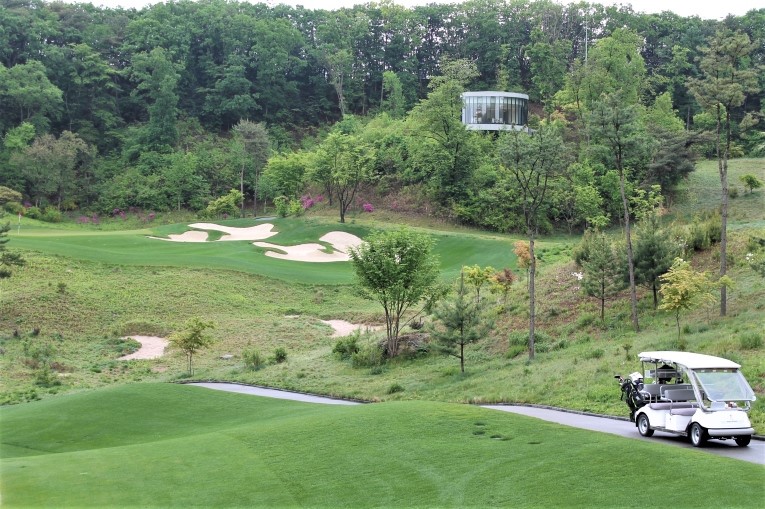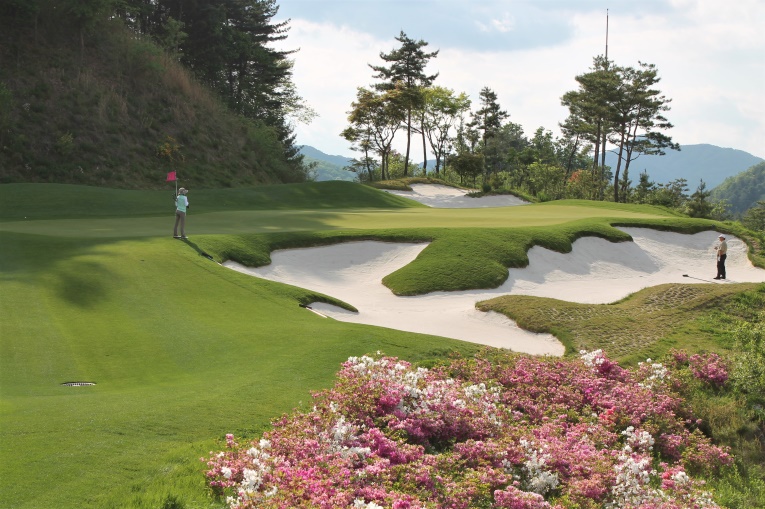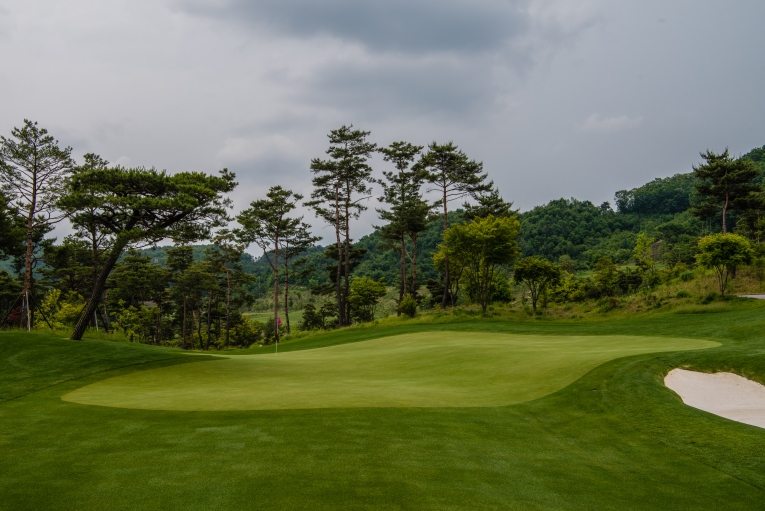Whistling Rock Country Club
Chuncheon-si, Gangwon-do, South Korea

Solitude, the sound of rushing water, and dazzling design elements give Whistling Rock an ambience all its own.
Part of the game’s lasting allure is the diversity of its playing fields. No two properties are identical and so no two courses are the same. Similarly, no two countries are culturally exactly alike. Many share similar beliefs toward family, work and relaxation but there are always variations and distinctions. Among the joys of exploration are seeing and experiencing what other countries value. For golfers, studying how different nationalities approach the game can provide a window into what a region cherishes. To that end, one of the most illuminating experiences the author has ever enjoyed is Whistling Rock, an hour and a half drive northeast of Seoul.
When the South Korean conglomerate Taekwang Group decided to develop a private golf club in 2006, Chairman Ho-jin Lee’s marching orders were ‘harmony of art and nature.’ The mandate was for the club to be within driving distance of Seoul but finding such a locale was no mean feat. According to Google, South Korea fits in the area between San Francisco and Los Angeles. From top to bottom, it is hilly, sometimes mountainous country where the Taebak ridge extends from North Korea down the peninsula to the southern part of South Korea. Nearly half the population resides around greater Seoul. It was intended that there be 27 holes so that a full day would be enjoyed. After two years of searching, a 425 acre parcel in a valley surrounded by uninhabited hills was assembled through a series of land acquisitions, mostly from farmers. Seclusion was guaranteed and the big picture of nature – a course set in a mountain valley – was achieved. When Seoul is hot and humid, breezes ‘whistle’ across the Gangwon Province mountains, thus the club’s name. In this cloistered environment the golfer certainly experiences one of the quietest rounds he will ever enjoy.
Extensive manipulation would be required of the rocky terrain to make it good for golf. That task was entrusted to the Californian-based firm of Robinson Golf Design, run by Ted Robinson Sr. and Jr. Unfortunately, Sr. passed away before construction commenced in 2009 and it fell to Jr. to carry on. At a time when new course construction had virtually ceased globally, Ted Robinson Jr. found himself in the enviable position of working for a client with great financial might. The creation of Whistling Rock Country Club was an enormous undertaking on three levels; the golf course, the landscaping which would include the interrelated water features, and the clubhouse and related structures. Play wouldn’t commence for three years.
Before turning our attention to the golf, let’s examine the Chairman’s use of the word ‘art’ which is multi-faceted at Whistling Rock beginning with the clubhouse. As a private club, a game here was always intended to be enjoyed in peace. It was presumed that 17,000 or so rounds a year would be played, so the option existed for a modest clubhouse to be built. Yet, this was one of South Korea’s most successful and influential conglomerates and the clubhouse in Korea is seen as the ‘face’ of the overall offering. While golf in Korea is in its infancy, one thing is readily apparent: at the high end, the standard for clubhouses is unmatched anywhere in world golf. Clubhouses function as art and can be counted among the finest buildings (let alone clubhouses) constructed this century. Be it South Cape, Haesley-Nine Bridges, or the Jack Nicklaus Korea course outside of Seoul, the design pedigree is stunning.
In the case of Whistling Rock, the Chairman was keen to create a sanctuary from city life that would help fuel the desire for people to make the drive from Seoul. With the conglomerate’s reputation on the line, Francine Houben from the Danish firm of Mecanoo Architects was hired to design the clubhouse and three tea houses. The end result? Possibly the finest clubhouse in the world, one that occupies 167,000 square feet, and certainly the author’s favorite large clubhouse. The long axis of this rectangular masterpiece of design extends 140 meters and fronts the course. Considering that girth, it is amazing how peacefully it occupies the land – many comment that it seems to ‘float’. Clean lines dominate and stone, glass and wood are the key components. Views from the elongated clubhouse windows are of grass, streams, waterfalls, rocks and hills. Cars are parked underneath, removing the blight of a large asphalt lot. From the club’s collection of 30,000 bottles of wine at the west end to the saunas at the east end, the entire building is spacious, utile and elegant. Bamboo gardens dot the minimalistic lux interior.
How something can be immense and yet discrete is a marvel. This building presides over much of the play and as photographer Joann Dost notes, “It is the anchor of the property with the eye always drifting back toward it.” Glimpses are afforded of it from 14 of the 18 holes on the Cocoon-Temple course and like Shinnecock Hills’s clubhouse, it sets a tone, albeit in a contemporary manner (if you think a clubhouse has to be traditional clapboard to hold appeal, don’t go to South Korea!). A student of design would revel in it. Ayn Rand’s Howard Roark, understanding the commitment of resources and capital required to bring it to fruition would celebrate.

From high on the Temple nine, the eye travels across the 8th and 9th holes of Cocoon toward the clubhouse.
Happily, the same care and thought that went into the clubhouse permeates all three nines where themed tea houses are found near the mid-way points of each layout. Choosing a favorite tea house is as difficult as picking a favorite nine; each is wildly different. On the Cocoon nine a tea house was built on the edge of a lake with tightly controlled oval views of a placid pond and the distant hills. The Temple tea house is larger and features wood and glass to great effect in creating an airy atmosphere. Lastly, the Cloud tea house is perched the highest from its surrounds and affords a view of the five holes on the property known as the Glen.
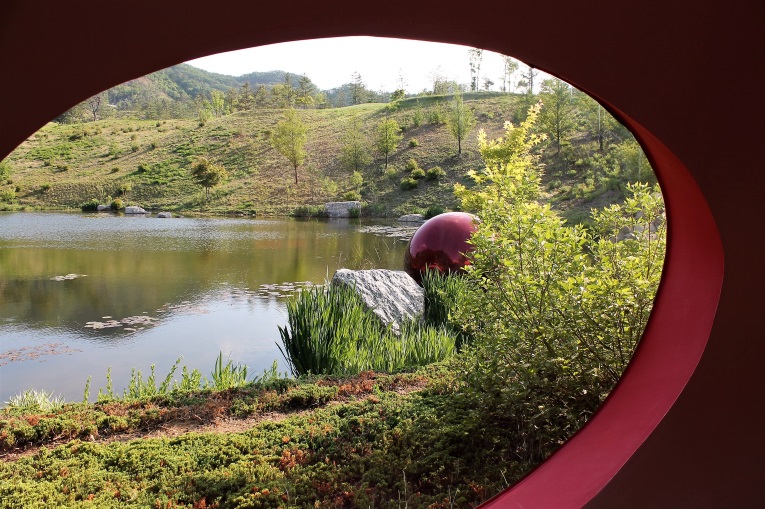
The eastern view is of a pond. In Korea, it is considered poor form not to stop at a tea house during the round.
An additional art installation is the nine various sized balls scattered across the twenty-seven holes. Seven are found on the clubhouse side of the property and represent the colors of nature (blue, red, navy, green, orange (as seen above out the Cocoon tea house window), violet, and yellow). For those spiritually inclined, this main section of the property (i.e. where twenty-two of the holes are found) is ‘life.’ Meanwhile, gold and silver balls are located over the hill in the Glen and to reach them you pass through a stone structure with two enormous twenty foot wooden gates. This upcountry portion of the property occupied by five holes represents ‘after-life.’
One can only imagine what Old Tom Morris or Willie Park would think of the high art found at Whistling Rock. To have such non-golf extravagances might be an anathema to them. That said, viva-la-difference between Scots and Koreans! These balls lend Whistling Rock its own voice in world golf. Having seen The Balls, the landscape without them would somehow seem less memorable, and therefore diminished. A tip of the cap to everyone involved for coming up with something so original with such discriminating taste.
Heading here, the author had his apprehensions. Mountain courses are as removed from the home of golf and linksland as possible and consequently, often suffer from one or several limitations: poor soil, fairways that – ironically – are bulldozed too flat, narrow playing corridors hewn through woodlands, holes that feel crammed onto the landscape hanging off ledges, and most commonly, a course that is not walker friendly. Additionally, many mountain courses were developed for the sake of selling homes and the development compromises long interior views and a sense of place.
Happily, none of those limitations are present at Whistling Rock. To his eternal credit, Ted Robinson did a masterful job of finding 27 playing corridors in his routing across the rural landscape. It can not be overstated what an enormous undertaking this project was and his holes frequently play toward distant mountain peaks (e.g. the approach to Cocoon Two, the tee ball on Temple Three) or the clubhouse. Robinson’s routing yielded a course that is by and large a delight to walk. A four person cart is provided for each group and I hopped-on only twice (from Cocoon Four to the fifth tee and downhill after the tee ball at Temple Three. Otherwise, it was a fine stroll because care is continually given to the walker, as evidenced by the steps behind Temple One and the shaded walk up to Cocoon Eight tee.
After transforming the rugged landscape into something suitable for golf, focus was turned toward re-establishing a pleasant setting rooted in nature. Any other outcome would have muted the Chairman’s words. Robinson shrewdly recommended Taekwang hire Pinnacle Design Company and its principal Ken Alperstein. Their landscaping ultimately created the property’s overall look and feel. Hundreds of trees indigenous to Korea, including the Japanese Red Pine, Korean Pine, Amur Maple, Japanese Maple, and the Kousa Dogwood were planted in areas altered by construction. Many of these like the pines and Japanese Maples add an appealing delicacy that contrasts with the otherwise masculine features. Deciduous plants, bushes and grasses were brought in to add texture and flesh back out nature. The photographs throughout this profile speak as the resounding success of this landscape undertaking.
While the course construction required wall to wall shaping à la Shadow Creek, an important difference was embraced. Both Pinnacle and Robinson thought it best to foster views of other holes throughout the round. This is something not necessarily popular in America and certainly goes against the grain in Asia. Their point of view was pressed on Taekwang Group’s contact, Mr. Ki Yoo Kim, now President of Whistling Rock. Kim’s concurrence was a defining moment during the three year construction and today long interior views give Whistling Rock a special place in world golf so rarely found on a mountain course. Jasper Park and Roaring Gap are notable exceptions but it’s exceedingly rare for one to enjoy so many sweeping views across so many holes.

Long views through tall pines across the interior are routinely afforded with the subject matter alternating between verdant short grass, rock ledges, water features and distant hills. There is much to admire.
Play commenced in 2012 and after three years of feedback from its members, a decision was reached to tweak the design in 2015. David Fisher, Vice President of International Business at Whistling Rock and who was previously the on-site landscape architect for Pinnacle during construction, knew Eric Iverson from their time together working on a Tom Doak project in China. Iverson initially worked for Doak in Virginia twenty years prior before joining full time in 2001. Iverson’s career at Renaissance Golf Design began with a bang, contributing to world class gems like Cape Kidnappers, St. Andrews Beach and Barnbougle. His work at Stone Eagle, tucked in the mountains and his time working for Perry Dye on brawny terrain in Japan provided direct experience for Whistling Rock.
Fisher like the idea of a consulting architect in the design-build mode, meaning someone who would make recommendations and then carry out the work himself. Whistling Rock was always going to be a Ted Robinson design but it was felt that enhancements made in a sympathetic manner by someone on site doing the work himself would be beneficial. Iverson arrived in November, 2015 and immediately headed to Cocoon. Iverson was duly impressed by the first green and quickly acknowledges that he ‘… has filed it away in my memory in case there is ever a project where we could use something like it. We certainly wouldn’t touch the first green – it was perfect as-is.’ At the same time, he thought, ‘Yet there were other opportunities to help such as creating more hole locations on Cocoon Three green and making Cocoon Six more playable for the less accomplished player. After touring the first nine, I felt good about working within the club’s framework and yielding a course that would be more enjoyable.’ Central to Iverson’s conviction was that Robinson ‘… had done a great job of focusing left and right and creating enough width. If he hadn’t done so well with the big picture stuff, an opportunity for me to lend meaningful help would not have existed.’

One of the most improved holes was Cocoon Six where the fairway was raised and the green lowered. Weaker players had struggled to complete it.
Iverson’s initial directive was to provide additional hole locations and enable more questions to be posed. As a case study, let’s examine the third hole on Cocoon. This long uphill two shotter culminated at a green that was high in the middle rear, allowing for drainage off the front and back. It also meant the putting surface was well above its surrounds and severe to the point that its 6,000 square feet rendered only five usable hole locations. The lead-in to the green was an abrupt five foot ramp that rejected most running shots. Iverson reduced the back of the green by 1/2 foot, the middle of the green five feet (!), and the front half four feet and pulled that dirt forward to level the approach. Shots can now be chased onto an open putting surface where a Maxwell puff in the middle of the green creates a series of baby bowls and a plethora of interesting hole locations. Both the approach shot and the likely recoveries are much more engaging, both visually and for the shots that they ask the golfer to play. It transforms the hole from being a good one with a severe green to a great one that is a treat to play. It rivals Cocoon Seven as the author’s favorite green on the property.
Iverson’s revisions garnered immediate praise when they were unveiled in the spring of 2017. Strategic components had been added to the Cocoon and Temple nines and the eighteen holes were now more in keeping with the standard set by the clubhouse and other facilities, as we see below.
Cocoon Course
First hole, 325 yards; On this proverbial gentle handshake three themes emerge. First, fairway bunkers matter at Whistling Rock; they’re on the large size and intrude into play from one side. Rarely does a straight line exist from tee to flag. Selecting driver is not an automatic decision as less will often allow the golfer to stay short of such hazards. Second, the putting surfaces are gracefully contoured like potato chips rather than abrupt contours. Third, the backdrops for the greens are invariably attractive and diverse.

As seen from 135 yards, the first green feeds off a hill on the right and drops down left to a wavy putting surface that features a mild false front.
Second hole, 550 yards; The only three shotter on the property that heads west takes advantage of the fact that it goes toward the low side of the property. After each shot, a grander and broader panorama unfolds, capped off by the view of the tree covered rolling hills some 1500 yards behind the green.
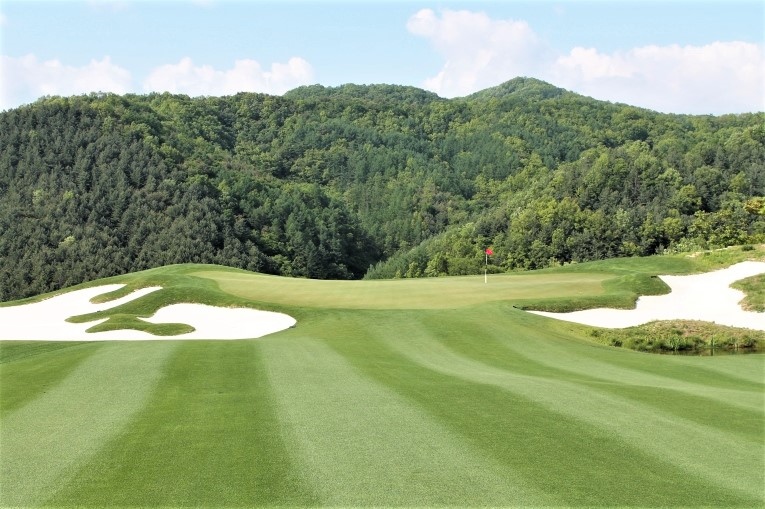
Hard to believe a city of nearly 25,000,000 is but one and half hours away. The clean lines of the green’s horizon do nothing to distract the eye from the setting’s beauty.
Third hole, 470 yards; The pacing of the holes at Whistling Rock is highlighted by ½ par holes liberally sprinkled throughout. Sandwiched between the reachable par 5 second and the drivable short fourth lies this brute. Robinson gives and Robinson taketh away! The golfer is never going to feel ‘out of the game’ as opportunity is rarely far away – just not now. The uphill approach shot is likely to be from 200 +/- yards and its difficulty is compounded by how the blue grass works in conjunction with the fairway contours. Tee shots are unlikely to yield a level stance in this rumpled fairway. The mindful golfer will adjust but hitting from uphill, downhill or side hill stances complicates matters. A standout green as previously noted completes the extreme challenge.
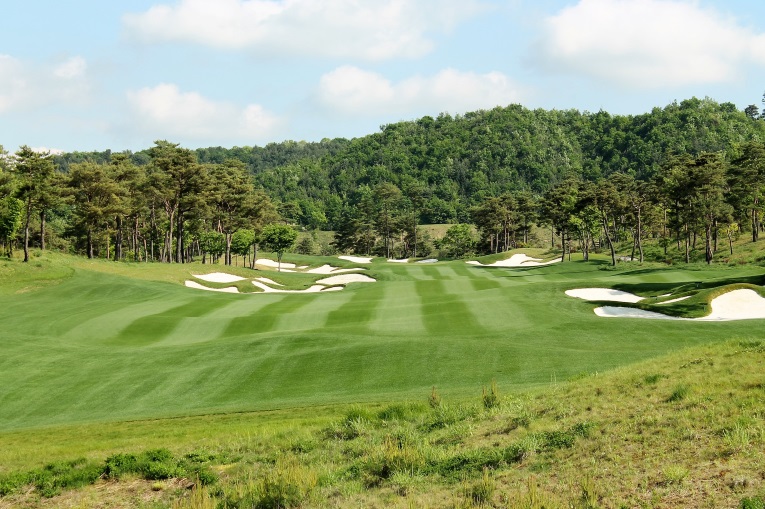
The nest of bunkers short right and long left lend genuine playing interest to a straight playing corridor.
continued >>>
Whistling Rock Country Club
Chuncheon-si, Gangwon-do, South Korea
Fourth hole, 325 yards; Given that the fairway pivots around a lake at an 80 degree angle, the direct tee-to-green line is considerably shorter than the card indicates. Having a go at the green is a genuine temptation. To thwart the tiger, Iverson shrunk the green in front and along the left side and placed a bunker short left of the green. As he notes, the bunker is only blind from the tee. For those that lay up with a three wood, it becomes visible front left of the green and makes the pitch less comfortable.

Tee balls come in from the right and need to be hit with a high fade to have any hope of holding the smaller green. Note Iverson’s new bunker front left and how the tight bank of short grass left of the green swoops misplayed shots away.
Fifth hole, 155 yards; While the fourth green is deep but none too wide, the target here is wide but none too deep. It seems obvious to avoid the deep front right bunker but long left is worse, such is the slope and pace of the back to front green. The climate at some 700 feet above sea level provides conditions ideal for good golf, something that is not as true for courses located in the southern region of the country.
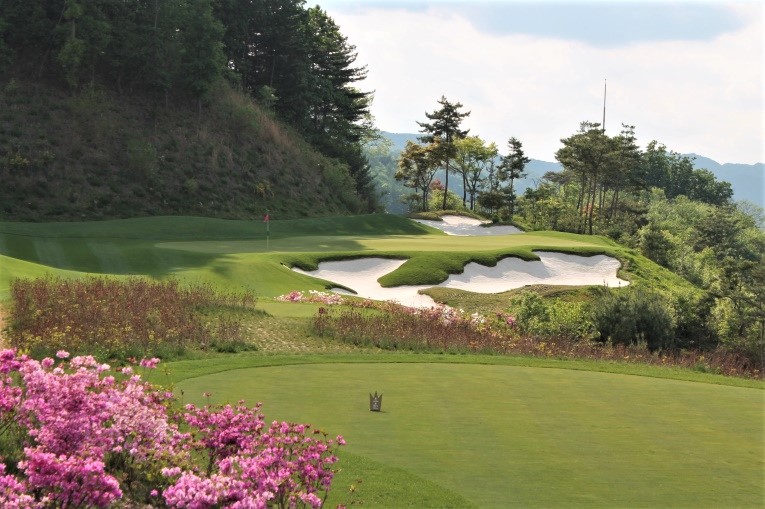
The reworked front bunker drips down the slope after Iverson reduced the turf between the bunker and the native area.
Sixth hole, 330 yards; Iverson’s past experience with Perry Dye in Japan indicated that perimeter holes in mountainous settings were often the most challenging and such proved true here. As previously noted, Iverson raised the fairway and lowered the green to give the player more appealing shots along the extreme western perimeter of the property. Bill Coore once told the author that Coore & Crenshaw would accept a project only once they knew they could find eighteen suitable holes. When asked to elaborate, he responded that one weak hole had the potential sink the perception of any course. According to several members, this hole was the worst of the twenty-seven to the point where mid-handicap players sometimes never finished it. Now, the drive is with anything from a driver to a five iron and the approach is to a heavily contoured – but visible – putting surface. Both shots readily appeal – and kudos for a marked transformation in removing the worst hole from the course.
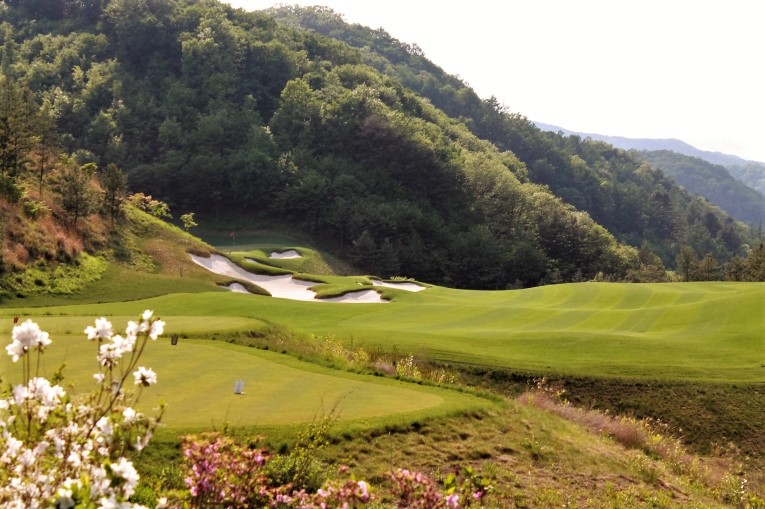
The short, tempting sixth – certainly a drive over the fairway bunkers will make the approach easier to the back right hole location seen above. Alas, that line is where the trouble lurks.
Seventh hole, 580 yards; The longest hole on the property not surprisingly embodies the property’s standout features. Additionally, Iverson used a leaning tree, left of the green to great effect by extending the putting surface behind it to create a neat lower bowl. His work here epitomizes his directive to create more options on the approach. A back lower left hole location begs for a running draw to funnel toward the rear from an approach played from the right portion of the fairway. Meanwhile, a front right hole location high on the plateau requires an aerial approach from the left portion of the fairway.

The twenty foot waterfall to the right captures the eye off the tee but it is the less obvious shallow valley in the left fairway that also needs to be avoided because it hinders forward roll, making the second shot blind.

The sound of rushing water is heard throughout much of the property, contributing to an overall serenity.

Whistling Rock has been open for five years – and it shows. Vegetation now drapes the rock ledges that were exposed during construction and softens the course’s profile as only nature can.

Iverson’s prime mandate was to create more fun hole locations for the members. This view from high right shows the enhanced flexibility and course set-up options that were created when he lowered and extended the left side of the green.
Ninth hole, 375 yards; The author’s three favorite holes on the property might well be the ninth on each nine. While quite different from one another, all enjoy the advantage of playing toward the incomparable clubhouse. Playing in the shadow of such a colossal design is rare. The Old Curmudgeon might harumph “What backdrop? I am here just for the golf.” The reality is something quite different and altogether awe inspiring; thoughts of playing golf in the National Mall in Washington DC toward one of the Smithsonian buildings dance in the head. Here the closing hole was markedly improved when Iverson pulled a left bunker forward to place it directly in the driving zone. Clearing it is no mean feat but the risk/reward is pitch perfect as the second shot becomes much easier from the left side of the fairway.

The golfer just creeped over the water hazard from the fairway bunker but the highlight is the handsome stone bridge in the background.
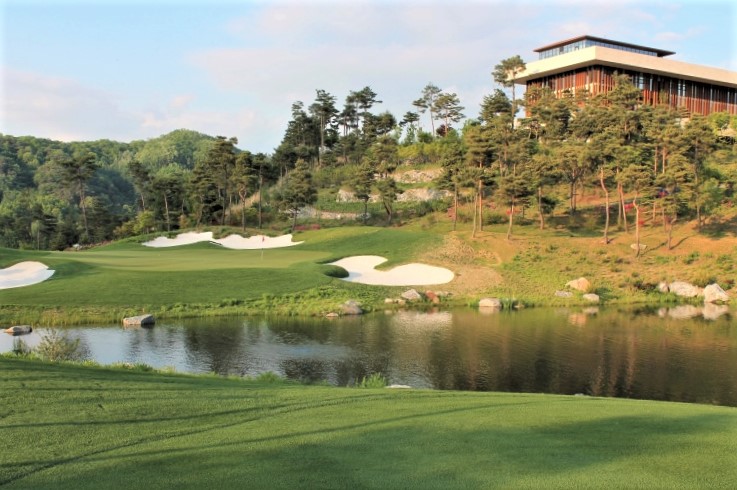
Front right hole locations become accessible only by those that drive over the newly created left fairway bunker.
Temple Course
First hole, 355 yards; The direct line from tee to green on most of the holes at Whistling Rock is invariably interrupted by some form of hazard. This is the height of good architecture. Here, a widespread fairway bunker juts into play from the right and the golfer must decide whether to flirt with it off the tee. The sight of the flag behind it certainly acts the siren but the prospect of hitting an approach shot off sand over the stream that fronts the green mutes greedy tactics. On the green, a dominant ridge crosses the putting surface producing a series of interesting hole locations. Having grown up on the east coast of America, I had not played a Ted Robinson design before arriving here and greens like this became a pleasant revelation.

The fairway bunker extends to the left edge of the green and the fairway swings right around it. See the ridgeline behind the green? It extends well up the mountain and has the appearance of the back of a dragon, especially from the vantage point of the clubhouse balcony. Dragons are revered in Asia as being all powerful, so the only restriction placed on Robinson on the entire project was not to touch that spine.

Several different shallow bowls exist within the 1st green on the Temple course. Often the play is to hit high left past the hole and let the approach feedback back toward it. The increased amount of grass that is maintained at fairway height along the front right of the green ominously filters toward the stream.
continued >>>
Whistling Rock Country Club
Chuncheon-si, Gangwon-do, South Korea
Second hole, 495 yards; This connector hole could have been a complete miss, similar to eight at Chambers Bay or five at Whistling Straits where neither feels a part of the fabric of the rest of the course. Temple Two plays surprisingly well and offers up some of the more heroic moments of the day. Much work was done by Iverson to balance the green site which hangs on a ledge and has a steep fall off right. By reworking the green contours and extending short grass well to the left, Iverson created more opportunities for more classes of player to enjoy this severely uphill hole. Allowing for kicks and bounces is what makes links golf fun and Whistling Rock now enjoys its fair share of such moments.
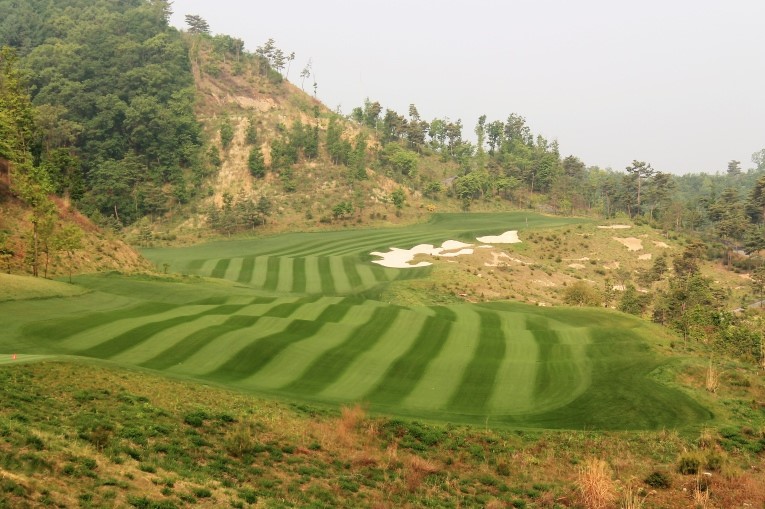
A bullet power fade chases to the lower right portion of the fairway where level lies are afforded. From there, the confident golfer might elect to hoist a 230 yard shot out over the valley wall in an effort to reach the green in two.

Similar to the 6th at Piping Rock and the 14th at St. Louis Country Club, a top hole location can add a whopping ½ shot to the day’s stroke average. Iverson strongly advises a running approach to the top tier. In addition to rebuilding the green, he pushed short grass well left of the green enabling all classes of players a way to finish the hole.
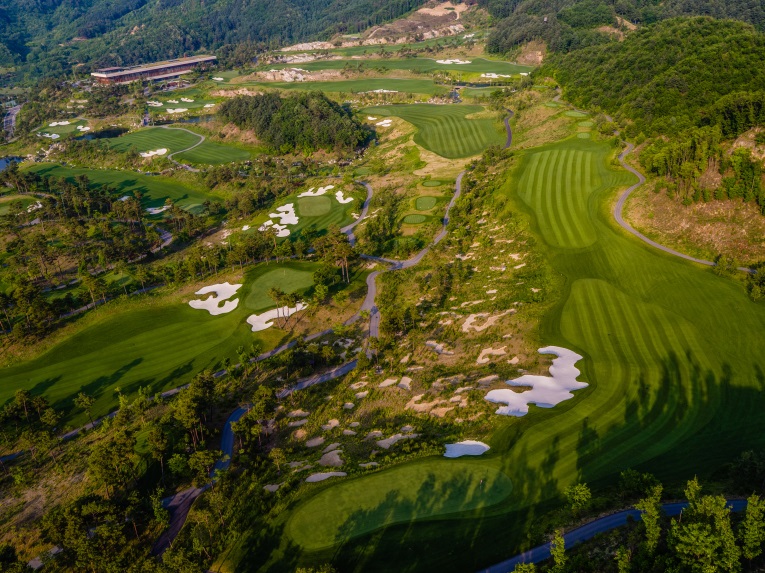
This photograph from Joann Dost’s drone captures the appealingly angled Temple 2 green. The golfer’s orientation to it varies greatly depending on where in the fairway he plays his approach.
Third hole, 430 yards; Eyeing the more than 100 foot tee to the fairway drop, the staunch traditionalist might sniff, knowing a cart ride will likely ensue. That seems small-minded, given that a cart for carrying four bags and four players accompanies every group (i.e. four people chatting amiably are never divided into two carts like they are in America – socializing isn’t interrupted at Whistling Rock). The upside to this drop shot tee ball is four fold: first, the sight of the ball suspended in air extends for over 10 seconds (!); two, the environment is so quiet that the sound of tee ball colliding with the fairway reverberates back up to the tee; three, the hole embraces the course’s mountain setting in an unshrinking manner; and finally most importantly, the shot has strategic merit for the golfer that hugs the hazard and enjoys the best angle for his approach.

High drama in South Korea – the view from Temple 3 tee where the playing angles are as good as the views.

Give Robinson credit for locating the green in a secluded pocket of the property and give Iverson credit for increasing the number of fun hole locations and for the short grass to the right. Overall, Iverson’s work yielded a net reduction in the number of bunkers and increased the amount of short grass around the greens.
Fourth hole, 415 yards; The ideal line off the tee hugs the right side hazard, the same dry stream bed that the golfer (hopefully!) avoided on the last hole. A driver brings the left fairway bunker into play so a three wood becomes a good option.
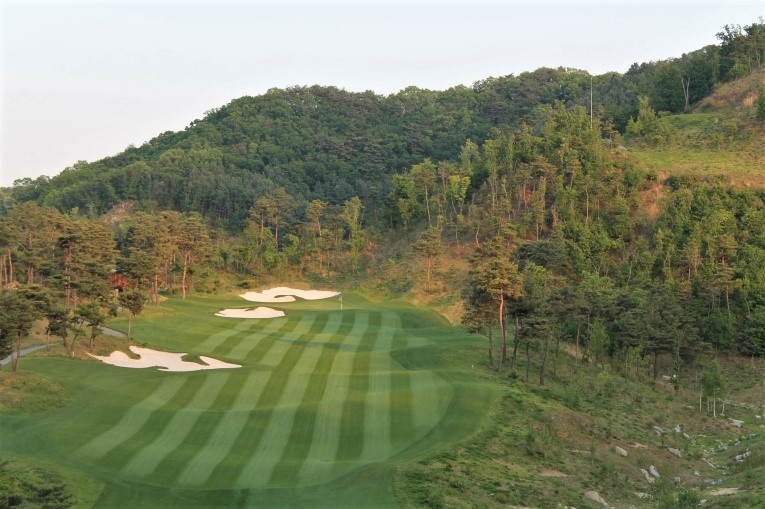
Should the golfer squeeze his tee ball down the right side of the fairway, avoiding both the lateral hazard right and the bunker left? Or just lay back with a 3 wood?

At least the Temple tea house is nearby to comfort the golfer who’s out of position and places his approach above the hole.
Seventh hole, 510 yards; On each of Whistling Rock’s three nines the seventh hole happens to be a 5 par. Those on Cocoon and Temple parallel each other heading in the same easterly direction. The obvious challenge was to make each hole distinct and Robinson did so from tee to green, helped by the waterfall at Cocoon and the course’s largest fairway bunker on Temple. Iverson extended the lower left portion of Cocoon’s green and that work nicely contrasts with the built-up, tightly-bunkered, pulpit green complex on Temple.
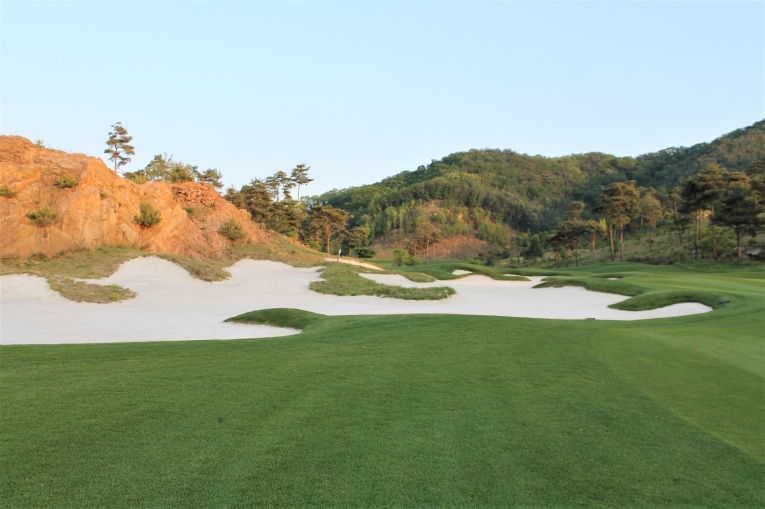
This rock formation was enhanced rather than hidden by the enormous bunker that Robinson built at its base.
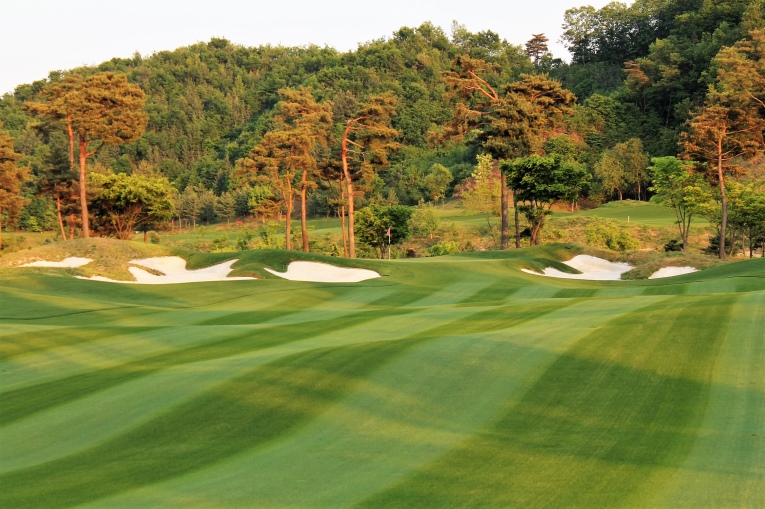
Where are we? California? The sinewy Japanese Red Pines add tranquility and peace to a course that belies its young age.
Eighth hole, 345 yards; Fairway contours take front and center stage on Iverson’s newly created hole. Two mindsets exist as to how to best tackle it. One has the golfer use the ridge in the fairway to shunt his tee ball left where he would enjoy a level lie and play up a channel toward the green. The other has him play long to the elevated outside of the dogleg from where he can look down and see most of the putting surface. A tee ball pushed weakly right of center will find a bank, perpendicular to play that kills forward progress. Though the fairway is immensely wide at 65 yards, the golfer who finds himself in this no-man’s will discover that he has a blind approach to the course’s smallest green. Tom Doak’s greatest designs all enjoy an innocent, wide fairway where ground contours can thrust shots into either advantageous or unfavorable positions. Here, Eric Iverson exhibits that same flair for terrorizing the golfer with intelligent contouring and abundant short grass.
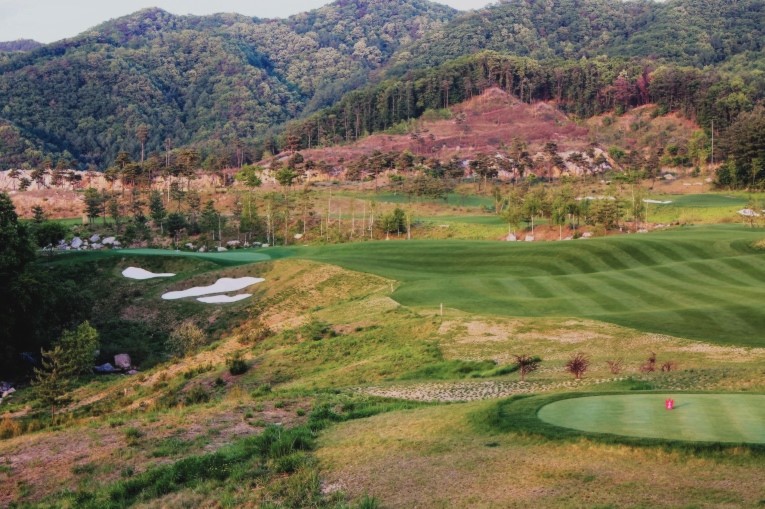
On land that was once a long par 3 hole, Iverson fashioned a tempting short par 4 that swings left around a native depression.

As seen from high on Temple 2, the two tiered Temple 8 fairway swings left around a native area. A 4,625 square foot green is the smallest on Cocoon-Temple.
Ninth hole, 175 yards; Whistling Rock sits on the edge of the Chuncheon Lake Basin which is fed by numerous streams that flow down the valleys off the Taebak Ridge. So, streams and water falls are very commonplace in a region where water features hold an exalted place. There is no more fitting a location for the final green than over a rushing stream in front of the clubhouse. Now this hole is a par 3 instead of the par 4 when the course opened. Iverson converted it to a one shotter in the fall of 2016, at the suggestion of work associate Jonathan Reisetter and course consultant Masa Nishijima. Credit must also be given to Club President Kim for embracing the idea and enabling Iverson. The alteration was anything but straightforward because this is the finishing hole for the best sequence on the three nines (e.g. Cocoon-Temple). Asking someone to agree to conclude their course with a par 3 is no small thing, especially in Asia where tradition is cherished. For the author there is no more fitting – or exhilarating – finish possible. Iverson’s expansion of the green and the new front right bunker lend the green a close connection to the cliff.
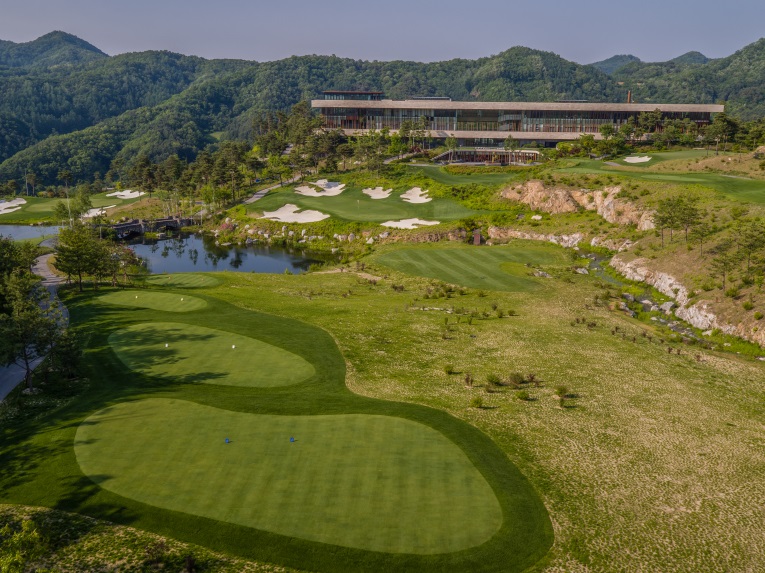
Temple 9 is less than one year old and is guaranteed to become one of the most photographed holes in Asia.

One benefit of converting the ninth to a par 3 is that the group is brought together on the tee. The author finds it inconceivable that the conversation wouldn’t be interrupted by the spectacle ahead.

As seen from high right, walking across the swinging bridge over the deep gorge is part of the profound pleasure of Temple 9. Iverson’s front right bunker and green expansion to the edge of the embankment enhance the hole’s flexibility. The putting surface itself renders a slew of big breaking putts, while listening to the churning water below.
Ever since Se Ri Pak broke onto the golf scene in the mid 1990s, South Korea has been creating its identity in the golf world. Today, its training schools produce an abundance of top draw players that dominate the LPGA tour on a regular basis. More recently, Korea hosted the 2015 President’s Cup on a Jack Nicklaus design on the outskirts of Seoul, and the drama was broadcast around the world. This country in its golf nascence is embracing the game while doing so by adding a flair all its own.

Not discussed in this profile is the Cloud Nine, which we will feature at another time. Here is its ninth hole, handsomely framed at dusk by the yellow ball and clubhouse.
Sometimes golf is more than the sum of the architectural merits of eighteen holes. Certainly, the history of St Andrews and the drama of Pebble Beach add to those occasions. There’s an exoticness and sense of serenity that pervades a round of golf at Whistling Rock. The natural landforms and man’s adornments are extreme yet so esthetically congruent that the place becomes irresistibly attractive. Whistling Rock demonstrates how East meets West to provide an indelible experience worth savoring on multiple levels, all the while being true to its heritage: The name Korea stems from Koryo, the dynasty that ruled for nearly four centuries. Loosely translated, it means ‘land of high mountains and sparkling streams’, which is exactly what the golfer experiences at Whistling Rock.

Over the past decade Chairman Ho-jin Lee’s vision of a harmony of art and nature was realized in a one-of-a-kind way that pays tribute to Korea.





